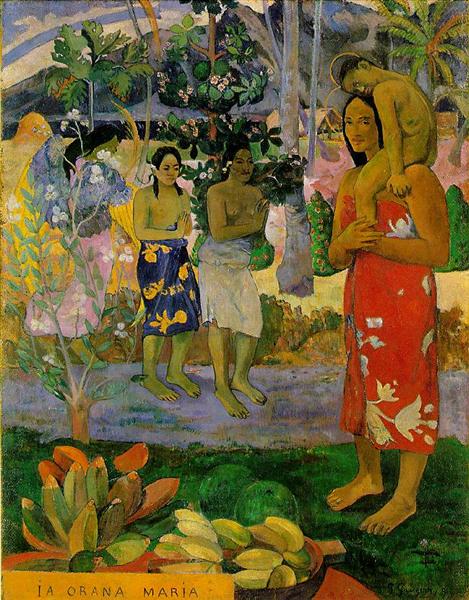Description
Paul Gauguin's "Ia Orana Maria" (We Hail Mary), painted in 1891, is a sublime representation of his signature style, which fuses symbolism and the influence of Polynesian culture. This painting is a parenthesis in time that invites the viewer to contemplate the deep spirituality and sense of the sacred that Gauguin sought to express through his art. The work reflects the artist's interest in religious iconography, but also his desire to imbue it with a personal and emotional visual language.
The composition of "Ia Orana Maria" is notable for its simplicity and the almost sculptural approach to the figures. At the center, two native Tahitian women, with their dark skin and vibrant clothing, bow reverently before a figure of the Virgin Mary, who stands on a higher plane, imbued with an aura of serenity. The figures, outlined with firm contours and relatively flat planes of color, evoke a sense of spirituality that is both reverential and earthy. The women's raised hands, charged with a symbolism of greeting and veneration, visually contract with the gesture of Mary, who seems to receive their devotion.
The use of colour is particularly evocative, a hallmark of Gauguin’s work that reveals his desire to evoke emotion. The colour palette is notable for its saturation and its ability to create an intense, almost mystical atmosphere. The deep blues and vibrant greens of the background contrast with the warm tones of the clothing, establishing a harmonious yet dynamic balance in the work. This treatment of colour not only serves to beautify the scene, but also acts as a vehicle to convey deeper moods and meanings.
The arrangement of the figures also plays a critical role in the painting’s visual narrative. The proximity between the women and the figure of Mary suggests a spiritual and cultural connection, while the presence of the lush vegetation in the background reminds us of the Tahitian environment that was so influential in Gauguin’s life and work. This cultural context becomes a framework that not only adorns the scene, but also gives the work a singular identity that challenges the Eurocentric view of religion and art.
“Ia Orana Maria” is, moreover, an exploration of the duality that encompasses the human experience: the connection between the divine and the earthly. Gauguin, by choosing to portray the Virgin Mary in a Polynesian context, is not only challenging cultural boundaries, but also allowing for a reflection on the universality of faith and spirituality. This work ultimately serves as a testament to Gauguin’s desire to infuse his art with a sense of authenticity, moving away from the artistic conventions of his time and embracing a deeply personal and evocative vision.
In short, Gauguin's "Ia Orana Maria" is a work that not only captures the essence of his artistic style, but also invites a reflection on the complexities of spirituality, culture and identity in a global context. With its carefully structured composition, rich palette and penetrating symbolism, it establishes itself as one of the most outstanding examples of the artist's work, and a milestone in the history of post-impressionist art. Gauguin's vision, in this painting, continues to resonate throughout the years, challenging the viewer to understand the dialogue between the sacred and the everyday.
KUADROS ©, a famous painting on your wall.
Hand-made oil painting reproductions, with the quality of professional artists and the distinctive seal of KUADROS ©.
Painting reproduction service with satisfaction guarantee. If you are not completely satisfied with the replica of your painting, we will refund 100% of your money.

